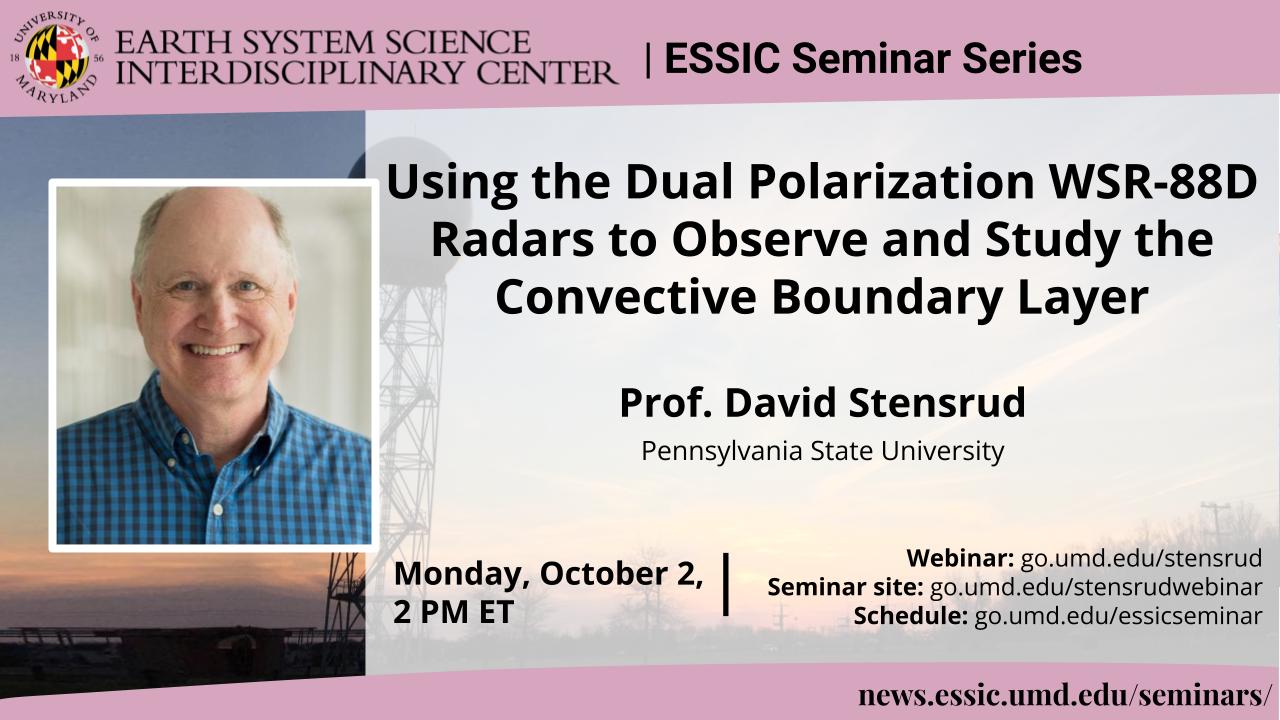
Using the Dual Polarization WSR-88D Radars to Observe and Study the Convective Boundary Layer
This event has passed. See the seminar recording here:
Prof. David Stensrud
Pennsylvania State University
Monday October 2, 2023, 2 PM ET
Abstract
The WSR-88D radar network was developed to advance the National Weather Service’s warning mission for high-impact weather events. The quality of the severe weather warnings issued from forecast offices across the US, and based upon observations from the WSR-88Ds, represents an incredible success story that can be discerned from the national news almost daily. The original Doppler radars were upgraded to dual polarization in 2013 to provide more accurate rainfall estimation and the 160 radars in the network are currently undergoing a service life extension program to keep them operational until at least 2030. A fortuitous outcome of the dual polarization upgrade is that it opened the door to an improved sampling of the convective boundary layer (CBL), which is the focus of this talk.
We have used observations from the WSR-88Ds to study horizontal convective rolls (HCRs) and cellular convection (cells) and their environments; explore multiple cases of wide HCRs over land; estimate the depth of the CBL; and estimate the depth of the entrainment zone at the top of the CBL. Selected results from each of these research areas will be presented and discussed, along with a brief introduction to the dual polarization WSR-88D radar and network.
The main take home message is that the WSR-88D radars are a tremendous resource for sampling the CBL, providing routine observations that can help to advance our understanding of the boundary layer.
Biosketch
David Stensrud is a Professor and past Head of the Department of Meteorology and Atmospheric Science at The Pennsylvania State University. His research has tended to focus on using model ensembles to predict severe weather events, but his work has also extended into data assimilation, convective-scale predictability, upscale feedbacks of deep convection on the environment, the North American monsoon, and the planetary boundary layer. Prior to joining the Penn State faculty in 2014 he was a research scientist at the NOAA National Severe Storms Laboratory for nearly 30 years. Stensrud received his BA in Mathematics and Meteorology from the University of Wisconsin-Madison, and his MS and PhD in Meteorology from The Pennsylvania State University. He has authored over 150 formal peer-reviewed publications, the book Parameterization Schemes: Keys to Understanding Numerical Weather Prediction Models and is a Fellow of the American Meteorological Society.
Webinar
Event site: https://go.umd.edu/stensrud
Zoom Webinar: https://go.umd.edu/stensrudwebinar
Zoom Meeting ID: 944 4563 7065
Zoom password: essic
US Toll: +13017158592
Global call-in numbers: https://umd.zoom.us/u/aMElEpvNu
For IT assistance:
Cazzy Medley: cazzy@umd.edu
Resources:
Seminar schedule & archive: https://go.umd.edu/essicseminar
Seminar Google calendar: https://go.umd.edu/essicseminarcalendar
Seminar recordings on Youtube: https://www.youtube.com/user/ESSICUMD

